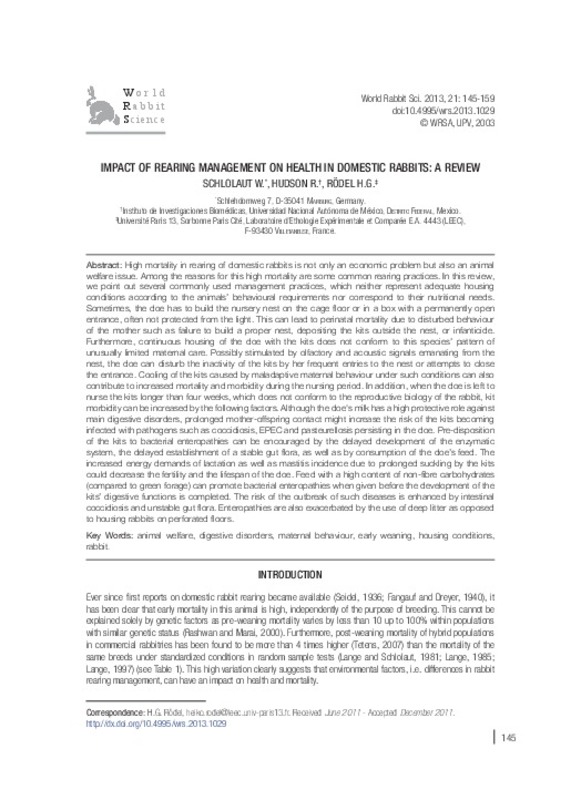|
Resumen:
|
[EN] High mortality in rearing of domestic rabbits is not only an economic problem but also an animal
welfare issue. Among the reasons for this high mortality are some common rearing practices. In this review, we point ...[+]
[EN] High mortality in rearing of domestic rabbits is not only an economic problem but also an animal
welfare issue. Among the reasons for this high mortality are some common rearing practices. In this review, we point out several commonly used management practices, which neither represent adequate housing conditions according to the animals' behavioural requirements nor correspond to their nutritional needs. Sometimes, the doe has to build the nursery nest on the cage floor or in a box with a permanently open entrance, often not protected from the light. This can lead to perinatal mortality due to disturbed behaviour of the mother such as failure to build a proper nest, depositing the kits outside the nest, or infanticide. Furthermore, continuous housing of the doe with the kits does not conform to this species' pattern of unusually limited maternal care. Possibly stimulated by olfactory and acoustic signals emanating from the nest, the doe can disturb the inactivity of the kits by her frequent entries to the nest or attempts to close the entrance. Cooling of the kits caused by maladaptive maternal behaviour under such conditions can also contribute to increased mortality and morbidity during the nursing period. In addition, when the doe is left to
nurse the kits longer than four weeks, which does not conform to the reproductive biology of the rabbit, kit morbidity can be increased by the following factors. Although the doe's milk has a high protective role against main digestive disorders, prolonged mother-offspring contact might increase the risk of the kits becoming infected with pathogens such as coccidiosis, EPEC and pasteurellosis persisting in the doe. Pre-disposition of the kits to bacterial enteropathies can be encouraged by the delayed development of the enzymatic system, the delayed establishment of a stable gut flora, as well as by consumption of the doe's feed. The increased energy demands of lactation as well as mastitis incidence due to prolonged suckling by the kits could decrease the fertility and the lifespan of the doe. Feed with a high content of non-fibre carbohydrates (compared to green forage) can promote bacterial enteropathies when given before the development of the
kits' digestive functions is completed. The risk of the outbreak of such diseases is enhanced by intestinal coccidiosis and unstable gut flora. Enteropathies are also exacerbated by the use of deep litter as opposed to housing rabbits on perforated floors.
[-]
|








